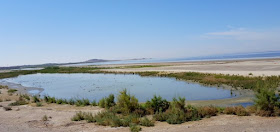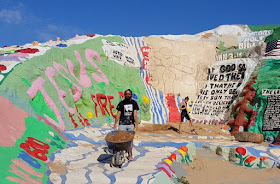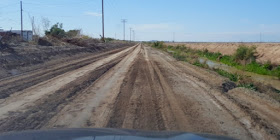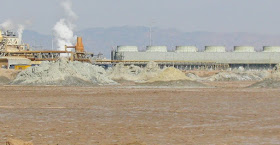The last two days have been filled with unexpected, but very informative tours. On our third (and final) day at Rio Bend Resort, it would have been easy to stay home and relax by the pool. But we had heard about an interesting road trip to our north. So we opted for hiking pants instead of swim suits as we headed out. We passed by the Spreckels sugar mill, where they process sugar beats into beautiful white sugar. We see from the line on the tower on the left that we are even going further below sea level.
We also recognize date palms growing along the highway today. Unlike those in the orchards that are carefully trimmed and thinned, these have full bracts of fruit hanging and going to waste.
Our destination today is the Salton Sea. It's one of the largest lakes in the United States, and can be seen as a large blue spot on the California map. We hiked to the top of the hill for a nice view of the beautiful blue lake.
Because of its large size, there is inviting blue water as far as we could see. But we didn't see any boats or swimmers or fishermen enjoying this blue water. That's because the Salton Sea was formed by a man-made mistake that accidentally re-routed the Colorado River to this low elevation space in California many years ago. Now the water is trapped here, as it is a terminal lake with no outlet. So it sits here getting saltier and stinkier. It is 25 percent saltier than the ocean, so the usual fresh water plants and fish can't live here, and the salty ones can't get here naturally. It smells sulphur-like because of the hydrogen sulfide produced by bacteria. One of the information kiosks at the nature refuge explained, "In addition to the hydrogen sulfide, also dead fish, geothermal plants, wetlands, agriculture, and the salty sea each add their sweet fragrance to the mix."
Now that beautiful blue lake doesn't seem near as inviting.
Instead of sand, the beach is made of barnacles, and littered with dead fish. It's sad to see this huge lake going to waste as it's not suitable for humans or animals.
Since there is no wildlife living in the lake, it seems curious that we are here at the Sonny Bono National Wildlife Refuge. That's because there are actually ponds that are completely separated from the sea, that do provide nice habitat for water fowl.
This area is an important fly-over stop for migrating birds, and there are thousands of geese and ducks in different areas of the park this time of year.
We watched as this avocet floated on one of the ponds, eating his lunch. That curved thin beak is used to sweep back and forth through the brackish water.
We also enjoyed seeing this long-legged black-necked stilt. He is well-named because it looks like he is indeed walking on stilts. His curious stilt legs bend backwards at the knees.
Besides water birds, there are also those that spend most of their time on land. This gambel quail ran from bush to bush, waving that plume on his head that Denisa calls a "party hat."
After spending some time in nature, we went in search for a man-made--but God inspired-- phenomenon. We had read about Salvation Mountain, out in the middle of the desert.
It was built by one man--Leonard Knight--who labored daily to turn this mole hill into a mountain.
Mr. Knight used hay bales, and whatever else he could scrounge from the local dump. He coated the bales with mud, and then painted them in bright colors.
His faithful helpers provided much of the paint, and we saw signs still soliciting for any paint leftover from projects to be donated to the mountain.
His main message to the world is that God is love. He also quoted bible verses and the Lord's Prayer all over Salvation Mountain.
To the right of the mountain is a maze of rooms and pathways that use trees and branches as their main support system.
We're pretty sure that this structure doesn't follow building code and isn't safety approved. We see large cracks forming in many of the hay bales. But it certainly was fun to see what one man felt inspired by God to create.
When Mr. Knight left the mountain at the age of 79, it was thought that the mountain would inevitably dissolve into the desert. But a faithful group has been working to maintain Salvation Mountain. We watched as they hauled dirt in preparation for repainting a decaying section of the mountain.
We totally expected to be the only ones visiting Salvation Mountain. But this beautiful weekend the parking lot was full and people were everywhere. Many of them weren't following the "please don't climb on the mountain" rules.
Everything that stands still gets a coat of paint and bible verses. There were several vehicles scattered around that looked like "mobile salvation mountains." But we're guessing that none of these vehicles were really mobile any more.
This area of the desert outside of Nigel, California, was once a World War II training ground. Now it is called "Slab City" and has turned into a haven for people in makeshift homes living off the grid. Scattered across the horizon are old RVs and tents.
There are a few solar panels, and a number of water tanks. But most of the sad campsites are a hodge-podge of tarps connected to ancient trailers. There doesn't seem to be time limits on camping, as some of these places look like they have been around a while.
Some of the residents of Slab City are self-proclaimed artists, using their trash to make works of art. We liked this better than the piles of trash around many of the campsites.
Another neighbor adorned a tree stump with old shoes to make a work of art entitled, "Sole Tree."
We had one more stop on this bizarre road trip. On the way, we passed by many of the geothermal plants throughout this area. They generate electricity from the steam produced from hot liquids under the ground.
We had read about "boiling mud pots" where people can see the results of this hot liquid coming to the surface of the earth. On the internet, we had seen pictures of hot cauldron-like holes of mud bubbling in the desert. We had directions that led us down some questionable roads that were made worse from the recent rains.
The directions we found on-line were pretty accurate, as we found the field of mud beside another geothermal plant.
But we also found these new signs that have been posted around the field. We also heard that more than one person has fallen through the crusty mud walking out to the mud pots. One victim had third degree burns all over his body before he could be pulled out of the hot water.
So our only mud pot pictures are taken with a zoom lens that show the mud mounds around the pots. Some times our adventures don't turn out like we plan, but the good news is we left the area without third degree burns.
So today was an interesting road trip. We saw some of Southern California's lesser known and less glamorous sites. But we were inspired that even in the middle of nowhere, salvation is being proclaimed and people are drawn to it.





























No comments:
Post a Comment